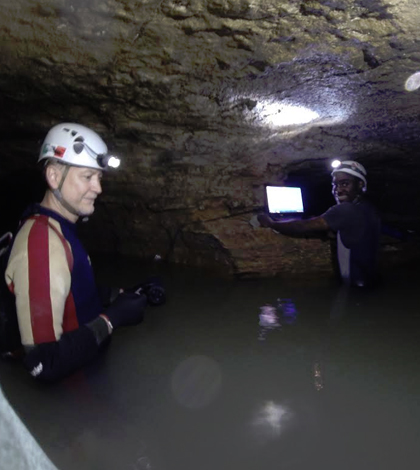Underground Study Charts Karst Aquifer Carbon Flux

Ball State University researchers working in a karst aquifer. (Credit: Lee Florea / Ball State University)
Regional water managers around the country are concerned with caring for groundwater resources, rightfully focusing on the health of aquifers beneath the feet of those depending on them. But along the Cumberland Plateau, the world’s longest hardwood forested plateau, these managers have to account for aquifers that fill caves, which aren’t found in most places.
This natural influence sets up a lot of interesting questions that scientists from a number of universities have begun dissecting. For a few from Ball State University, the curiosities lie in the movements of carbon and nutrients through a karst aquifer in south-central Kentucky.
Near the spring outlet of the aquifer, researchers from the university have deployed a YSI EXO2 Multi-Parameter Water Quality Sonde to monitor conditions there, with a specific focus on the nutrients moving through it. One goal that they have is to determine where the substances are coming from, the agricultural areas surrounding the study area or some other source.
“Our primary focus in this investigation is upon the flux of inorganic and organic carbon, as well as other nutrients,” said Lee Florea, an assistant professor of geological sciences at the university. “Therefore, data of primary interest from the EXO2 are temperature and pH for carbonate speciation, specific conductance for computing the flux of principle dissolved species based upon models from discrete samples, and fDOM (fluorescent dissolved organic matter) to estimate the flux of organic matter.”

Ball State University researchers working in a karst aquifer. (Credit: Lee Florea / Ball State University)
Those data will help to answer a lot of questions for Florea and Gilles Tagne, a doctoral student in Florea’s lab who is leading the work. But data on fDOM will be especially illuminating for the study’s focus, as scientists will be able to relate the fDOM information with samples analyzed for nitrogen species, reactive phosphate, specific ultraviolet absorption (SUVA) and carbon isotopes.
“A major component of this study involves estimating the fractional contributions from septic systems and confined animal feeding operations for poultry,” said Florea.
So far, some of the data collected have been considered, Florea says, but drawing concrete conclusions from them is not yet possible. But amongst the data are still some useful preliminary results.
“Nitrogen and phosphate are elevated as expected,” said Florea. “(The) fDOM values spike during storm events and, combined with SUVA values, suggests the rapid transfer of organic matter from the land surface with limited degradation.”
After all the data have been analyzed, plans are to publish them in peer-reviewed journal articles. Findings from the investigation will also be shared with the Kentucky Division of Water to help their management approaches, as well as with landowners in the area affected by the karst aquifer water quality.
Funding for the effort was provided by the Geological Society of America, the Cave Research Foundation and the National Speleological Society.
Top image: Ball State University researchers working in a karst aquifer. (Credit: Lee Florea / Ball State University)





0 comments